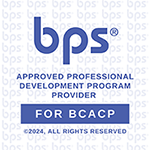ACCP collaborates with ASHP on Ambulatory Care Pharmacy activities.
Program Overview
The ACCP/ASHP Ambulatory Care Pharmacy Preparatory Review and Recertification Course is ideal for pharmacy professionals who are preparing for the Ambulatory Care Pharmacy Specialty Certification Examination administered by the Board of Pharmacy Specialties (BPS) and for those seeking a self-paced review and refresher of disease states and therapeutics.
Developed by Board Certified Pharmacists and clinical experts, the course content is based on the domains, tasks and knowledge statements outlined in the BPS Ambulatory Care Pharmacy content outline. The course content provides a comprehensive review of the knowledge domains covered in the specialty certification examination. The course uses a case-based approach, with strong emphasis on the thought processes needed to solve patient care problems in each therapeutic area.
The course is available for continuing pharmacy education and recertification credit.
ACPE Release date: April 3, 2024
ACPE credit expiration date: March 7, 2027
BCACP Release date: May 1, 2024
BCACP credit expiration date: April 29, 2025
Technical Requirements
Commercial Support
The American College of Clinical Pharmacy does not solicit or accept external commercial/financial support for its continuing pharmacy education activities. No commercial/financial support has been solicited or accepted for this activity.
Pricing Options
- For complete package pricing, click "Complete Packages" then "CPE Credit" or "Recertification Credit"
- For online workbook pricing, click "Workbook Only"
Standard Package
This course format is available for ACPE continuing pharmacy education credit.
To access the online course, you will need a login which will consist of your e-mail address and a password. Instructions on how to access the course will be provided on your receipt.
Online Course Package
Offers up to 24.5 continuing pharmacy education credits
Includes:
- online workbook - downloadable/printable PDFs
- streaming audio/slide synchronized presentations
- downloadable mp3 audio files
- downloadable mp4 video files
- downloadable/printable PDFs of presentation slides
- practice exam
- 24.5 hours continuing pharmacy education (CPE) credit
The ACPE Universal Activity Numbers are listed under the CPE/Recertification Credit section.
|
| Price: $645.00 |
Member: $440.00 |
|
BCACP Recertification Package
This course format is available for BCACP recertification credit and continuing pharmacy education credit.
To access the online course, you will need a login which will consist of your e-mail address and a password. Instructions on how to access the course will be provided on your receipt.
Online Recertification Course Package
Offers up to 24.5 continuing pharmacy education credits/recertification credits
Includes:
- online workbook - downloadable/printable PDFs
- streaming audio/slide synchronized presentations
- downloadable mp3 audio files
- downloadable mp4 video files
- downloadable/printable PDFs of presentation slides
- Recertification Posttests
- 24.5 hours BCACP recertification credit
The ACPE Universal Activity Numbers are listed under the CPE/Recertification Credit section.
|
| Price: $695.00 |
Member: $490.00 |
|
Individual Non-CPE Products
The following item is sold separately and DOES NOT include continuing pharmacy education credit or BCACP recertification credit.
To access the online workbook, you will need a login which will consist of your e-mail address and a password. Instructions on how to access the workbook will be provided on your receipt.
Online Workbook
Includes:
- online workbook - downloadable/printable PDFs
|
| Price: $275.00 |
Member: $170.00 |
|
A short excerpt from the Gastrointestinal Disorders session of the 2015 Pharmacotherapy Preparatory Review and Recertification Course:
The 2024 ACCP/ASHP Ambulatory Care Pharmacy Preparatory Review and Recertification Course includes the following components:
- An online workbook as a collection of PDFs. The workbook includes:
- Chapters offering a comprehensive review of the full scope of Ambulatory Care Pharmacy.
- Over 200 patient cases with explained answers to enhance your case-based learning.
- Over 200 self-assessment questions with explained answers.
- Current and relevant references at the end of each chapter.
- Audio-synchronized slide presentations available online. View slide presentations and listen to faculty as they review each presentation, slide by slide. The audio-synchronized slide presentations include:
- Downloadable/printable PDFs of presentation slides.
- Downloadable mp3 audio files.
- Downloadable mp4 video files.
- Continuing Pharmacy Education Credit
- 24.5 hours continuing pharmacy education (CPE) credit
- Recertification Credit - Available with recertification package.
- 24.5 hours BCACP recertification credit
Standard Package
Standard Package is available for ACPE continuing pharmacy education credit on April 3, 2024.
2024 ACCP/ASHP Ambulatory Care Pharmacy Preparatory Review and Recertification Course includes:
- online workbook - downloadable/printable PDFs
- streaming audio/slide synchronized presentations
- downloadable mp3 audio files
- downloadable mp4 video files
- downloadable/printable PDFs of presentation slides
- practice exam
- 24.5 hours continuing pharmacy education (CPE) credit available
Recertification Package
Recertification Package is available for BCACP credit on May 1, 2024.
2024 ACCP/ASHP Ambulatory Care Pharmacy Preparatory Review and Recertification Course includes:
- online workbook - downloadable/printable PDFs
- streaming audio/slide synchronized presentations
- downloadable mp3 audio files
- downloadable mp4 video files
- downloadable/printable PDFs of presentation slides
- Recertification Posttests
- 24.5 hours BCACP recertification credit available
Continuing Pharmacy Education Credit
 The American College of Clinical Pharmacy is accredited by the Accreditation Council for Pharmacy Education as a provider of continuing pharmacy education.
The American College of Clinical Pharmacy is accredited by the Accreditation Council for Pharmacy Education as a provider of continuing pharmacy education.
 The American Society of Health-System Pharmacists is accredited by the Accreditation Council for Pharmacy Education as a provider of continuing pharmacy education with Commendation.
The American Society of Health-System Pharmacists is accredited by the Accreditation Council for Pharmacy Education as a provider of continuing pharmacy education with Commendation.
 The American College of Clinical Pharmacy and the American Society of Health-System Pharmacists are approved by BPS as a provider for the recertification of BCACP.
The American College of Clinical Pharmacy and the American Society of Health-System Pharmacists are approved by BPS as a provider for the recertification of BCACP.
The Universal Activity Numbers (UAN) for the 2024 ACCP/ASHP Ambulatory Care Pharmacy Preparatory Review and Recertification Course are:
- Communication Strategies in Pharmacy; Trial Design and Biostatistics; Practices and Processes of Care
Activity Number: 0217-9999-24-015-H04-P
4.5 contact hours
- Diabetes; Obstetrics and Gynecology; Dermatologic and Eyes, Ears, Nose, and Throat, and Immunologic Disorders
Activity Number: 0217-9999-24-016-H01-P
3.5 contact hours
- Bone/Joint and Rheumatology; Developing and Managing a Clinical Practice; Endocrine Disorders
Activity Number: 0217-9999-24-017-H01-P
4.0 contact hours
- Genitourinary, Electrolytes, and Nutritional Deficiencies/Supplementation in Older Adults; Gastrointestinal Disorders; Pulmonary Disorders
Activity Number: 0217-9999-24-018-H01-P
4.0 contact hours
- Psychiatric Disorders; Neurology; Cardiology I
Activity Number: 0217-9999-24-019-H01-P
4.0 contact hours
- Cardiology II; Infectious Diseases I; Infectious Diseases II
Activity Number: 0217-9999-24-020-H01-P
3.5 contact hours
- Nephrology
Activity Number: 0217-9999-24-021-H01-P
1.0 contact hours
All continuing pharmacy education activities associated with the 2024 ACCP/ASHP Ambulatory Care Pharmacy Preparatory Review and Recertification Course are application-based activities.
Methods and CE Requirements
Continuing Pharmacy Education Credit
Activities consist of audio/video/PDF files, attestation statements, and activity evaluations. Learners must purchase the product, review all content, complete the attestation statements and course evaluations to receive continuing pharmacy education credit for each activity. You must submit the attestation statements and course evaluations associated with each activity within the course by March 7, 2027. Only completed assessments will be eligible for credit; no partial or incomplete assessments will be processed.
National Association of Boards of Pharmacy - CPE Monitor Service
Provided through the collaborative efforts of the National Association of Boards of Pharmacy (NABP), the Accreditation Council for Pharmacy Education (ACPE), and ACPE-accredited providers, the CPE Monitor Service allows you to electronically keep track of continuing pharmacy education (CPE) credits from ACPE-accredited providers. ACPE-accredited providers, like ACCP, are responsible for transmitting this information to NABP to be stored in the CPE Monitor system. Statements of credit will be available at CPE Monitor, nabp.pharmacy/cpe-monitor-service/, within 2–3 business days after completion of this activity. For more information on CPE Monitor please visit nabp.pharmacy/cpe-monitor-service/.
To transfer these credits to CPE Monitor on your behalf your NABP e-Profile ID Number and date of birth must be listed on your ACCP account. To verify or update this information in your ACCP account, visit Licensure/Certification. Be sure to save your changes at the bottom of the page.
Some international pharmacists do not use the CPE Monitor service. To verify or update this information in your ACCP account, visit Licensure/Certification. Check the box “I am an international pharmacist or I am not licensed to practice in the United States, and do not have an NABP e-Profile ID.” Be sure to save your changes at the bottom of the page.
Recertification Credit
To be eligible to earn BCACP recertification credit for this course you must purchase the recertification version and submit and pass the web-based posttest associated with each module within the course by April 29, 2025. The passing point to earn BCACP recertification credit is based on an expert analysis of the assessment items in each posttest module. Any posttest submitted before the BCACP posttest deadline that meets this passing point will earn BCACP recertification credits. These credits will be assigned as of the date of test submission. For statements of recertification credit, visit www.bpsweb.org.
All participants must have a Board of Pharmacy Specialties (BPS) board certification credential number, BPS ID Number, and a BPS expiration date on file with ACCP for reporting purposes. To verify or update this information in your ACCP account, visit Licensure/Certification. Be sure to save your changes at the bottom of the page.
Questions regarding the number of hours required for BCACP recertification should be directed to BPS at (202) 946-5026 or www.bpsweb.org.
The ACCP Recertification Dashboard is a free online tool that can track recertification credits as they are earned through ACCP and schedule new opportunities for credits from upcoming ACCP professional development programs.
Faculty*Content matter experts
 |
Paul M. Boylan, Pharm.D., BCPS
Assistant Professor
The University of Oklahoma Health Sciences Center
Oklahoma City, Oklahoma |
 |
Erica Crannage, Pharm.D., FCCP, BCPS, BCACP
Associate Professor
Pharmacy Practice
St. Louis College of Pharmacy at
The University of Health Sciences & Pharmacy;
Clinical Pharmacist
Mercy Clinic - Family Medicine
Saint Louis, Missouri |
 |
Spencer H. Durham, Pharm.D., BCPS, BCIDP
Assistant Clinical Professor
Department of Pharmacy Practice
Auburn University
Harrison College of Pharmacy
Auburn, Alabama |
 |
Jessica F. Farrell, Pharm.D.
Clinical Pharmacist
Albany Medical Center Division of Rheumatology;
Professor and PGY2 Ambulatory Care Pharmacy Residency Program Coordinator
Albany College of Pharmacy and Health Sciences;
Associate Medical Officer
Steffens Scleroderma Foundation
Albany, New York |
 |
Alicia B. Forinash, Pharm.D., FCCP, BCPS, BCACP
Professor of Pharmacy Practice
St. Louis College of Pharmacy at
The University of Health Sciences & Pharmacy
Saint Louis, Missouri |
 |
Nicole M. Hahn, Pharm.D., BCACP*
Clinical Pharmacy Specialist – Neurology
Kaiser Permanente
Denver, Colorado |
 |
Diana Isaacs, Pharm.D., FCCP, BCPS, BCACP, BC-ADM, CDCES, FADCES
Endocrine Clinical Pharmacy Specialist
Co-Director – Endocrine Disorders in Pregnancy
CGM Program Coordinator
Cleveland Clinic Endocrinology & Metabolism Institute
Cleveland, Ohio |
 |
Adam B. Jackson, Pharm.D., BCACP*
Clinical Pharmacy Specialist, Infectious Diseases
Kaiser Permanente Colorado
Denver, Colorado |
 |
Hanlin Li, Pharm.D., MBA, BCACP
Lead Clinical Pharmacy Manager
NewYork-Presbyterian
New York, New York |
 |
Joel C. Marrs, Pharm.D., M.P.H., FCCP, FAHA, FASHP, FNLA, BCACP, BCCP, BCPS, CHC, CLS
Professor
Department of Clinical Pharmacy & Translational Science
University of Tennessee Health Science Center
College of Pharmacy
Nashville, Tennessee |
 |
Kevin Malloy, Pharm.D., BCPS, BC-ADM, CDCES
Clinical Pharmacy Specialist - Endocrinology
Cleveland Clinic
Cleveland, Ohio |
 |
Michelle T. Martin, Pharm.D., FCCP, BCPS, BCACP
Clinical Pharmacist and Clinical Associate Professor
University of Illinois at Chicago
Chicago, Illinois |
 |
Jamie L. McConaha, Pharm.D., BCACP*
Associate Professor
Pharmacy Practice
Duquesne University
Pittsburgh, Pennsylvania |
 |
Emily K. McCoy, Pharm.D., FCCP, BCACP
Associate Clinical Professor
Auburn University
Harrison College of Pharmacy
Mobile, Alabama |
 |
Molly G. Minze, Pharm.D., FCCP, BCACP
Associate Professor of Pharmacy Practice
Associate Dean for Student Affairs and Admissions Abilene Campus
Jerry H. Hodge School of Pharmacy
Texas Tech University Health Sciences Center
Abilene, Texas |
 |
Melissa C. Palmer, Pharm.D., BCPS
Clinical Pharmacy Practitioner – Mental Health
Alaska VA Healthcare System
Anchorage, Alaska |
 |
Katie J. Suda, Pharm.D., M.S., FCCP
Professor
University of Pittsburgh School of Medicine
Pittsburgh, Pennsylvania |
 |
Jessica Tilton, Pharm.D., BCACP
Clinical Assistant Professor
Clinical Pharmacist
Medication Therapy Management Clinic;
Clinical Coordinator
University of Illinois at Chicago
Chicago, Illinois |
 |
Elizabeth Van Dril, Pharm.D., BCPS, BCACP
Clinical Assistant Professor
University of Illinois at Chicago
College of Pharmacy
Chicago, Illinois |